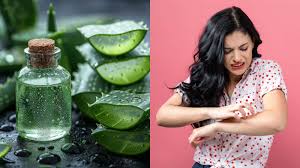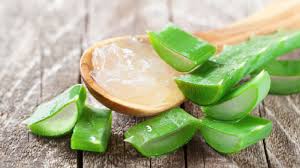
Aloe Vera: 7 Ways to Get Rid of Skin Rashes with This Home Remedy
Rashes are common skin conditions that can be treated at home. If you are looking for home remedies for skin rashes, you should try aloe vera.
Aloe vera, sometimes called the burning plant, has been used for centuries to treat a variety of skin conditions, including acne. This succulent has a gel that is rich in vitamins, minerals, and amino acids. Whether you have a mild itch or a severe rash, aloe vera can help you feel better and feel better. It also has anti-inflammatory properties that reduce redness and swelling, and its antibacterial properties help fight infection. Learn why aloe vera is one of the best remedies for skin rashes and how to use it.
What is skin rash?
A rash is an itchy or swollen area of skin that can change color, texture, or feel. It can appear in many forms, including redness, bumps, blisters, or patches. The rash can be itchy, painful, or both, and may be accompanied by other symptoms like fever or fatigue.

Causes of skin rash
Rashes can be caused by many things, from mild irritation to underlying medical conditions. Here are some causes.
1. Contact Dermatitis
Contact dermatitis is a rash caused by contact with an irritant or allergen. It can be divided into two types: irritant contact dermatitis and allergic contact dermatitis. Irritant contact dermatitis occurs when the skin comes into contact with a harsh substance or irritant, causing an immediate reaction. Allergic contact dermatitis is an allergic reaction to a specific substance (usually a metal or chemical) to which the body is sensitive. Research published by StatPearls found that in both cases, the skin becomes inflamed and irritated, often causing redness, itching and swelling.
2. Atopic dermatitis or eczema
Atopic dermatitis (AD) is a type of eczema and the most common inflammatory skin disease. It is a chronic skin condition that usually appears in infancy or childhood and causes itching, redness, and rashes, according to research published by StatPearls.
3. Psoriasis
Psoriasis is a skin condition that causes thick, scaly patches on the skin that become red and itchy. According to research published in the Journal of Clinical Medicine, plaques can form anywhere on the body, but are most often seen on the elbows, knees, scalp and back.
4. Environmental conditions
Contact with harsh chemicals, soaps or detergents can cause skin irritation. Heat, humidity or dryness can also cause redness. Finally, stress can increase existing skin conditions or cause new skin conditions to form.
Skin rash symptoms
Rashes can appear in many ways, but common symptoms include:
- Redness – The affected area is usually red or painful.
- Itching – This is common and can cause severe pain.
- Pain – Some rashes can cause pain or discomfort.
- Dryness – The skin can be dry, flaky or cracked.
- Rashes or hives – These may appear in the affected area.
- Scaling – The skin may appear scaly or crusty.
- Swelling – The area will be swollen or raised.
- Fever – Sometimes the rash can cause a fever.
Aloe Vera: Is It a Good Treatment for Skin Diseases?
Aloe vera has soothing and healing properties, which make it a good remedy for skin rashes. The gel in aloe vera leaves contains vitamins, minerals, and amino acids that can help heal skin conditions. A study published in the Indian Journal of Dermatology found that it also has anti-inflammatory properties that can reduce redness, swelling, and itching associated with rashes.
Aloe vera also has antibacterial and antifungal properties that help prevent infections and aid in healing. Applying aloe vera gel directly to the affected area can soothe and rejuvenate the skin.

How to use aloe vera to treat skin rashes?
Aloe vera is one of the best home remedies for skin rashes. Here are some expert-recommended ways to use aloe vera to treat skin rashes:
1. Use pure aloe vera gel
Ingredients:
Aloe Vera leaves
Directions:
Take an aloe vera leaf, slice it vertically and scrape out the gel.
Apply pure aloe vera gel directly on the affected area.
Wait for it to dry.
Soothes and reduces redness and pain.
2. Aloe Vera Gel and Almond Oil
Ingredients:
1 tablespoon aloe vera gel
1 tablespoon almond oil
Directions:
Add 1 tablespoon aloe vera gel and 1 tablespoon almond oil in a bowl.
Apply gently to your skin.
Leave on for 10-15 minutes.
Wash off with warm water.
This medicine provides rapid relief from dry rashes and soothes and moisturizes the skin.
3. Aloe Honey Mask
Ingredients:
1 tablespoon aloe vera gel
1 tablespoon honey
Directions:
Put 1 tablespoon aloe vera gel and 1 tablespoon honey in a bowl.
Apply to the affected areas.
Leave on for 10-15 minutes.
Wash off with warm water.
Honey has antibacterial properties to help fight infection, while aloe vera is soothing and moisturizing.
4. Aloe Vera Gel and Vitamin E
Ingredients:
1 tablespoon aloe vera gel
1 tablespoon vitamin E oil
Directions:
Put 1 tablespoon aloe vera gel and 1 tablespoon vitamin E oil in a bowl.
Gently apply to the itchy area.
Massage until absorbed by the skin.
Vitamin E has anti-inflammatory properties that help reduce itching and loose skin. Use with aloe vera to further soothe skin.
5. Aloe Vera and Coconut Oil
Ingredients:
1 tablespoon aloe vera gel
1 tablespoon coconut oil
Directions:
Put all the ingredients in a bowl.
Gently massage the affected area.
Coconut oil has moisturizing properties that help hydrate the skin, while aloe vera soothes inflammation.
6. Aloe vera and rose water
Ingredients:
1 tablespoon aloe vera gel
2 drops water
Directions:
Put all the ingredients in a bowl.
Gently apply to the affected area.
Leave on for 10-15 minutes.
Wash off with warm water.
This mask helps to quickly relieve redness.
7. Aloe Vera and Oatmeal
Ingredients:
1 tablespoon oatmeal
1 tablespoon aloe vera
Directions:
Mix aloe vera gel with oatmeal to make a paste.
Apply to affected areas
Leave on for 15-20 minutes.
Rinse with warm water.
While oatmeal helps reduce itching and irritation, aloe vera has beneficial effects.
Warning: Before applying aloe vera gel to a large area, do a patch test on a small area of skin to make sure you are not allergic to it. If you have side effects or if your rash does not improve, seek medical attention.

Are there any side effects of using aloe vera to treat skin rashes?
Although aloe vera gel is generally safe for most people, the following side effects should be noted:
Some people may be allergic to aloe vera. If redness, itching, or swelling occurs after using aloe vera, stop using it and seek medical attention.
In some cases, excessive or prolonged use of aloe vera can cause dryness or flaking of the skin.
Talk to your doctor before using aloe vera gel, especially if you are taking blood-thinning medications.
